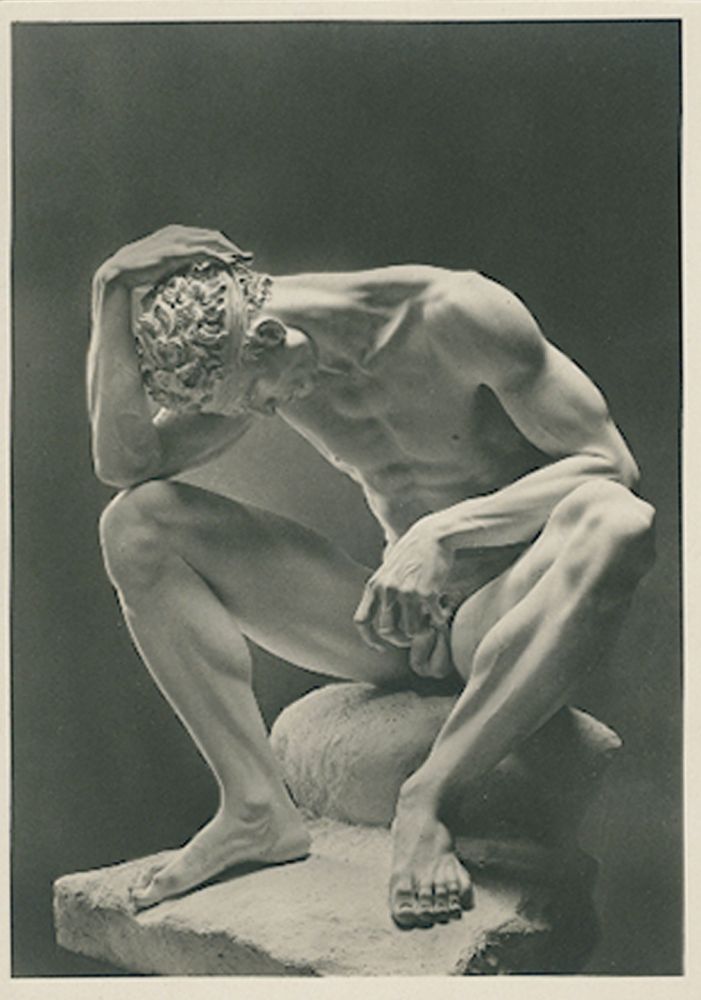"Der Verwundete"
sculpture by Arno Breker (1900–1991), 1938
gelatin silver print
Charlotte Rohrbach took photographs for reportages, including her first fashion photographs for the magazine "Die Dame" in 1934. She became famous for her photographs of the works of architect and sculptor Arno Breker. He was considered one of the most prominent artists of the National Socialist German Reich. In Adolf Hitler's opinion, his sculptures were "probably among the most beautiful things ever created in Germany".1 Rohrbach had a lifelong artistic friendship with Breker. This began in the early 1930s, when the young Breker moved from Paris to Berlin.
The German photographer's pictures were published in magazines such as Die Kunst im Dritten Reich and in books. More than almost any other photographer of her time, Charlotte Rohrbach was able to set new standards in black and white photography. As a photographer, she was often compared to the director Leni Riefenstahl. However, with her reserved nature, Rohrbach was unable to take on a similar official role in the Nazi era as her famous colleague. In 1942, she took part in the SS diatribe Der Untermensch.2
(Christoph Fuchs)
On the sculpture “The Wounded”, 1938 by Arno Breker
The sculpture was intended as one of the four masculine figures created to surround a monumental sculpture of Apollo with his quadriga. The group of sculptures was never achieved. It was destined to occupy the main roundabout of the new Berlin to be built by architect Albert Speer.
The complex iconographic program was intended to glorify the beginning of a new national socialist era. In the book published in 1942 by Charles Despiau on the occasion of Arno Breker’s solo exhibition in L’Orangerie des Tuileries in Paris, the sculpture is entitled Le guerrier blessé (The wounded warrior). No injuries can be seen on the muscled body of the Wounded. Only the presence of a headband can indicate a physical injury or, most probably, a psychological injury.
The sculpture could by then be read as an allegory of Germany seeking to recover its power after the defeat and humiliation of the First World War.
Although Arno Breker conceived the Wounded as a command for a public and allegorical monument, he nevertheless gave the sculpture a specific identity and introduced anecdotic elements in his project. Even if the facial expression of The Wounded couldn’t be seen by the viewer, Arno Breker gave the sculpture the face of the French cyclist André Leducq published in the French newspapers a few years earlier.
A few years later, he even casted a separate sculpture as a portrait: The Head of the Wounded. One copy of this work is also part of the Hugo Voeten Collection. The Head of the Wounded functions as an autonomous portrait of Leducq, Arno Breker paying an homage to a man he stayed into contact with until at least the late 60’s (as archives documents testify).
(Simon Delobel, Collection Hugo Voeten)
Notes
1
"Bauten der neuen Zeit" in: Alpenländische Rundschau. Unpolitische Wochenschrift für die gesamten Alpenländer / Alpenländische Rundschau, 24.12.1938, p. 8 (online at ANNO).
2
see wikipedia, Charlotte Rohrbach (https://de.wikipedia.org/wiki/Charlotte_Rohrbach, accessed 4.10.2024)
